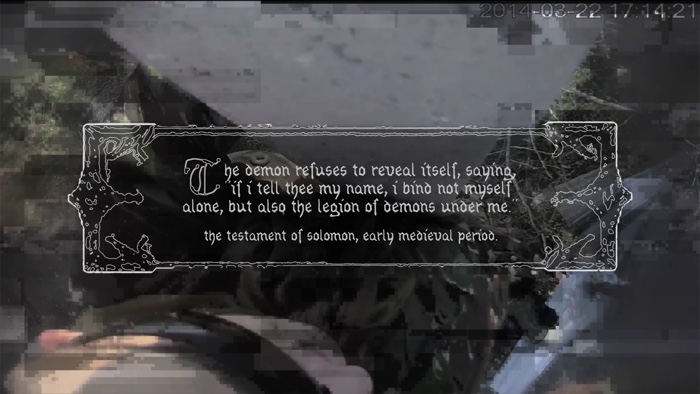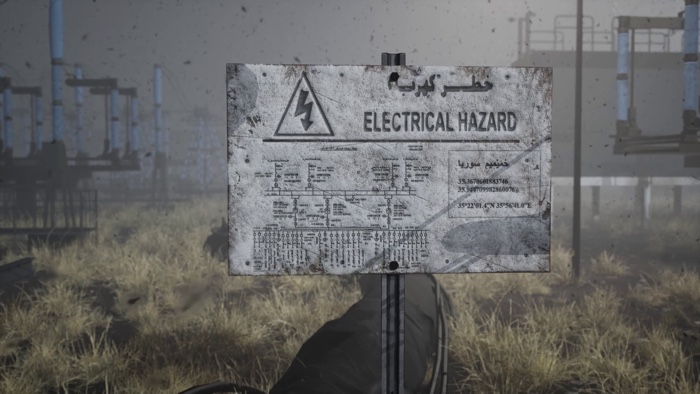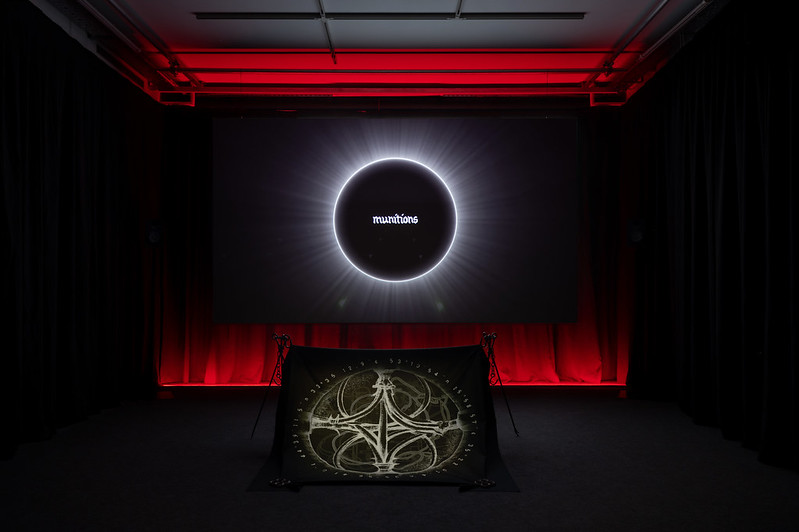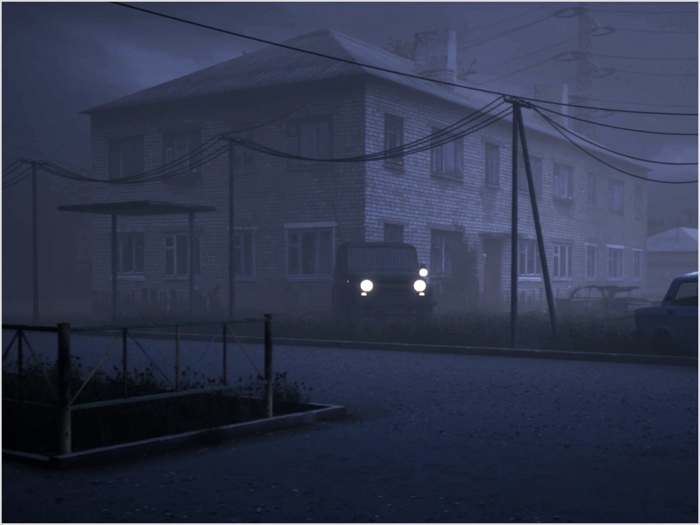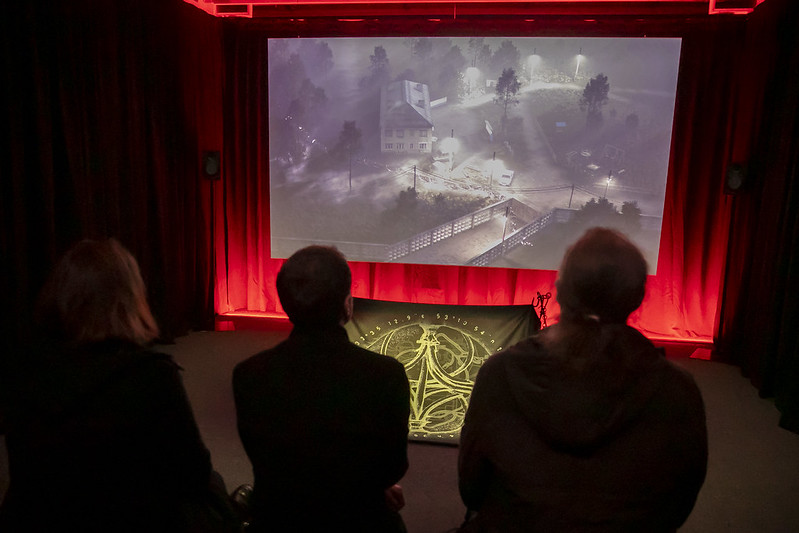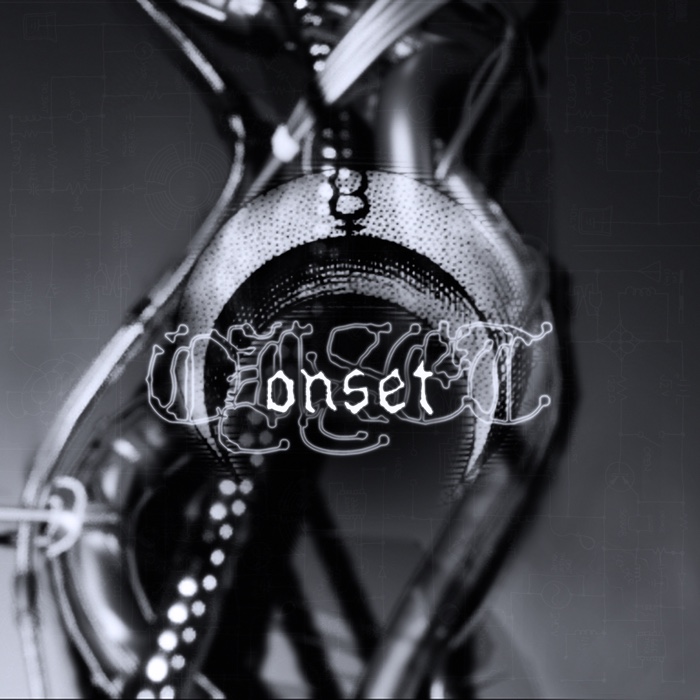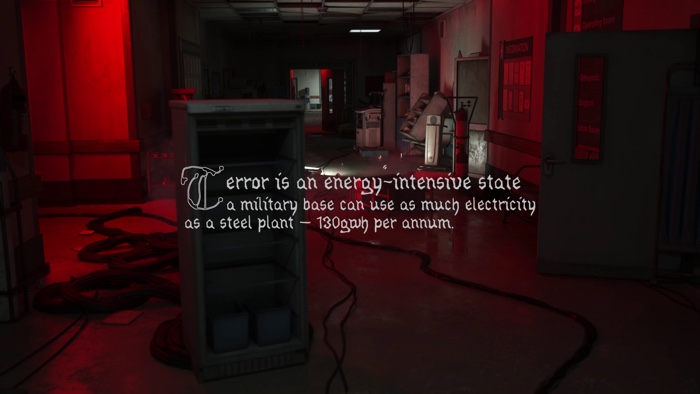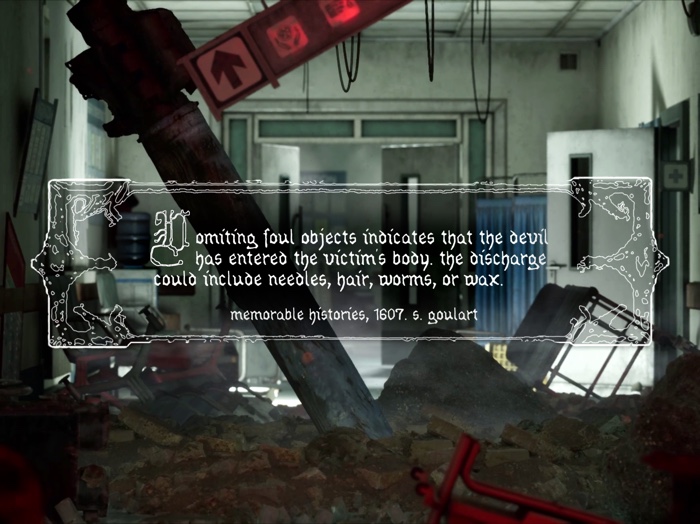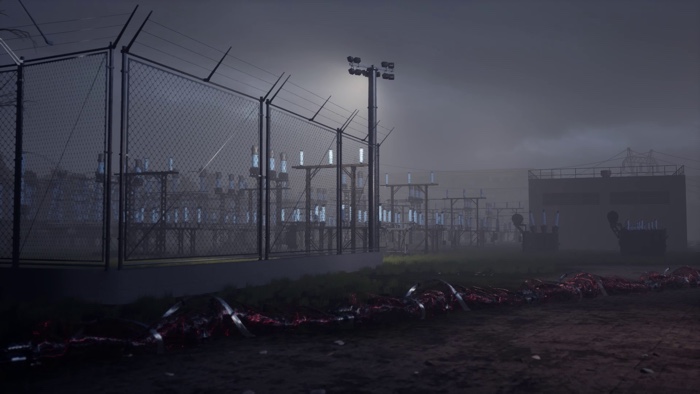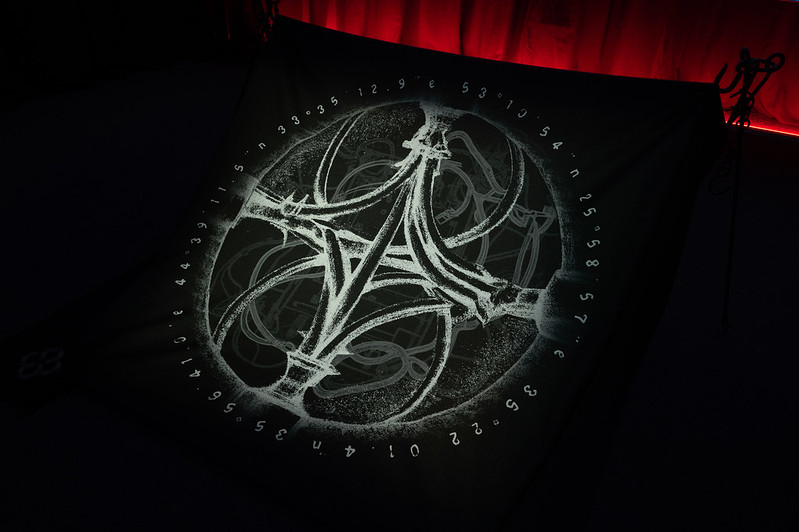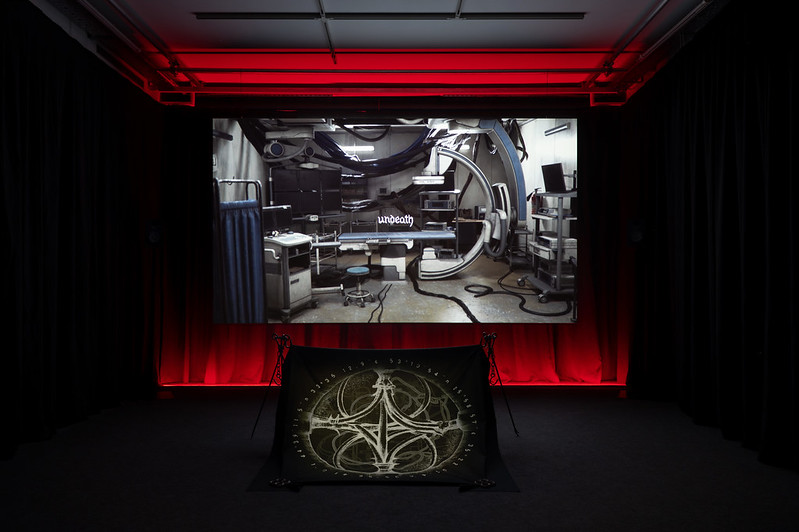How do you convey the methodical coldness of Russian colonial violence? How do you document the dawning of an invasion that has been repeatedly denied by the aggressor? How do you expose its stealth? How do you communicate its horror when attention fatigue around the topic starts to creep up?
Anna Engelhardt and Mark Cinkevich, Onset, 2023. Installation view at Aksioma Project Space. Photo: Domen Pal / Aksioma
Anna Engelhardt and Mark Cinkevich, Onset (Still from the film), 2023
Ana Engelhardt and Mark Cinkevich attempted to answer those questions with a short film that conjures demons and reveals the infrastructures that sustain the Russian military invasion. Onset is the result of meticulous research that combines mediaeval demonology, open-source intelligence and CGI animation. It focuses on three locations: Khmeimim, a Syrian airbase currently operated by Russia; Baranovichi, an air base in Belarus where Russia has been conducting military drills; and Belbek, a military airfield near Sevastopol, Crimea, now operated by the Russian Ministry of Defence.
The parallel the artists make between Russian imperialism and demonology is that, in stories of possession, a demon takes control of the body from within. It acts as a parasite that enters a body and gradually consumes all its resources from within, funnelling energy away from its body, bleeding it dry, and reducing it to an empty shell.
The artists found that in all three case studies, the onset of invasion echoes that of demonic possession. It starts with an infiltration rather than with an open confrontation. This quiet foray maintains the appearance of normalcy. In demonology, a demon always seeks to obfuscate and hide its name. Soon though, the destruction from the inside begins. Russian troops come unannounced, denying and destroying any proof of their presence. They spread throughout the country from within, taking control over and destroying its vital infrastructure. The invading force then reconstructs the destroyed infrastructure but only to the bare minimum needed to aid the invasion, without any regard for those living under the occupation.
The film guides you inside a spooky CGI environment reconstructed using satellite images of Russian air bases and other documents found online. It uses the usual tropes of horror movies: the location looks remote. Inside, the rooms are empty, the corridors chilling and visitors enter at their own peril. As a visitor, you suspect the presence of an unknown force…
Anna Engelhardt and Mark Cinkevich, Onset, 2023
Anna Engelhardt and Mark Cinkevich, Onset, 2023. Installation view at Aksioma Project Space. Photo: Domen Pal / Aksioma
Anna Engelhardt is the alias of a media artist, researcher and writer whose practice examines infrastructures of post-Soviet cyberspace through a decolonial lens, with the overarching aim of dismantling Russian imperialism. She examines war as a technology, looking into the hardware and software behind Russian invasions. Mark Cinkevich is a postcolonial researcher and artist whose scholarly focus is on tracking emergent trends in the post-Soviet infrastructural and social landscape, with particular attention to exploring the concepts of nuclear colonialism, infrastructural colonialism, extractivism and monstrosity.
I got in touch with them a few weeks ago, as their exhibition had just opened at Aksioma in Ljubljana:
Anna Engelhardt and Mark Cinkevich, Onset (Trailer), 2023
Hi Anna and Mark! I’m very curious about the mix of demonology and technology in your work. What does demonology, a study that is associated with religious beliefs, occultism and myths, bring to your research?
Anna: Our practice combines open-source investigations and para-fictional narratives to deal with instances of Russian colonial violence. Having worked against Russian colonial violence before the recent escalation of the Russian invasion of Ukraine, we are currently rethinking our practice to address the new context of the full-scale war. As you will see from this interview, Russian expansion before 2022 was undertaken as a covert operation, every aspect of which has been extensively denied. Proving that the Russian soldiers invaded the country was a task in itself. This military strategy has been surpassed by the highly mediatised war crimes in which Russia publicly takes pride. As a result, the questions we are asking ourselves at the moment are: What is the new role of investigatory art practice in such an environment? What does it mean to reconstruct a crime scene, the perpetrator and the process of which is known?
In the film, a demon roams through an ominous synthetic environment, reconstructed from satellite images of Russian air bases: Khmeimim in Syria, Baranovichi in Belarus and Belbek in Ukraine. Passing through their deserted corridors, interrogation rooms and electricity substations, this parasitic force sprawls out from the military structures. Devastation follows in its wake. In Onset, we crafted an unholy alliance of medieval demonology, open-source intelligence and CGI animation to uncover the secret life of these military outposts. Over the course of the film, the true horror of Russian colonialism becomes manifest in the process of possession – the imposition of external control that gradually destroys an organism from within.
We show that in all the cases we discuss, the onset of invasion is eerily similar to that of demonic possession – quiet infiltration that aims to uphold the image of seeming normalcy while corrupting the system.
In demonology, a demon always seeks to obfuscate and hide its name since it grants power to an exorcist. In an eerily similar vein, Russian troops always come unannounced, hiding their insignia and destroying any proof of their presence. They spread throughout the country from within, taking control over and destroying its vital infrastructure. They weaponise these structures to aid their advance, replacing civilian functions with military ones–turning the sovereign states against themselves.
Mark: We are interested in using the ideas of demonology in our work also because both demonology and monster studies have an element of the unknown. At the core of monstrosity, there is this element that is ungraspable and that can not be eliminated. It is the opposite of forensics. With demonology, there is also a tendency to think between fact and fiction. We do take myths and metaphors seriously. Demonology has a lot to offer in this regard, especially in the context of our research on Russian imperialism.
It is not always possible to rationalise Russian imperialism. That’s where demonology and monster studies equip us with tools that help us deal with the irrational. In a lot of investigative practices, the sequences of events that took place in the past get analysed. We can’t do that with demons. They have no foresight, they do not plan, they just carry their job and this is the scariest part of working with that topic. We can predict or anticipate, but only to a certain degree. All we know is that the demons are there and that they will continue to operate and corrupt.
Anna Engelhardt and Mark Cinkevich, Onset (Still from the film), 2023
I think that it is in this presentation you gave in Ljubljana that you explain that you are interested in the infrastructure horror genre. Can you explain how horror articulates realities about the extractive infrastructure that more factual or traditional narratives might not be able to fully reveal?
Anna: As Mark mentioned, we found several limitations when working with open-source investigations. This is where infrastructural horror as a genre came in.
Investigations are frequently characterised by a detached, sterile perspective, in which embodied experience is dismissed unless it is verified. Together with Mark, we tried to make sense of the mismatch between such distanced perspective and the reality of the graphic horror it aims to represent. We explored this tension in the new film “Onset”, recreating a horror movie’s embodied, limited perspective. A viewer/protagonist of the film, radically vulnerable to the unknown threat, follows the narrative of the satellite images investigation. To achieve this effect, we crafted the new notion of ‘infrastructural horror’, a genre that amplifies inherent dread hidden within extractivist infrastructures. This genre aims to create discomfort, repulsion or suspense by exposing the architecture of dispossession and destruction as a foreboding.
Mark: Because we work with large-scale infrastructures, there is a correlation between something of huge scale and the fear it provokes in us. The bigger a thing is, the more power it has, sometimes beyond our understanding. This phenomenon is sometimes referred to as the sublime. Something so massive that we can’t see it in its entirety. This is the case with energy infrastructures and the infrastructures used for military invasions. The element of invisible that we can’t eliminate when we deal with bases becomes a form of power. When we cannot know precisely everything, there remains an element of surprise and that is what makes it scary.
Anna Engelhardt and Mark Cinkevich, Onset, 2023. Installation view at Aksioma Project Space. Photo: Domen Pal / Aksioma
Anna Engelhardt & Mark Cinkevich, Onset, film poster, 2023
One of the things that ONSET, the video installation you were showing at Aksioma, communicates is that terror is energy-intensive. Can you expand on that?
Anna: The energy dimension is one of the core elements of the whole project. When we talk about infrastructural horror in this film, we do not talk about infrastructural horror as a kind of abstract concept. When we talk about foreboding, we talk about keyboards, wires and power substations that allow for this Russian colonial violence to exist.
Mark: Air bases as such, among all the military infrastructures, are the ones that have the biggest demand for electricity. This means that air bases are not just buildings in the middle of nowhere. They are connected to other infrastructures, usually to civilian infrastructures. A base on its own cannot generate all the energy it needs so it gets attached to the larger energy grid of the invaded country. Locating the source, in turn, allows us to locate other substations and transmission towers, which is what we teach in the workshops. This is also where the possession metaphor comes in because an air base needs to have an uninterrupted energy supply. As a consequence, all the needs of other civilian infrastructures, even hospitals, factories and schools, will be sidelined. That’s how a country loses control over its own body, how it gets alienated from its own infrastructure.
Anna Engelhardt and Mark Cinkevich, Onset (Still from the film), 2023
You work a lot with open-source data and open-source intelligence (OSINT) tools to investigate Russian air bases and Russian colonialism. Perhaps I’m very naive but I would have thought that since the invasion of Ukraine, Russia might have tried to make it as difficult as possible to investigate its infrastructures and classified information related to its military and security infrastructure. How robust and accurate are open-source data and OSINT? I would imagine that Russia might be good at hiding critical infrastructures.
Mark: There hasn’t been any drastic change since the escalation in the availability of open-source data. In fact, it might be that there’s even more data available now. There is not only resistance and people leaking data but there is also more data generated, making it easier for us to cross-reference and possibly confirm specific information from different sources. The escalation made cross-referencing easier. Just to give a concrete example, when we were looking into the air base in Belarus, we found that a lot of information had been published about this base before. Russian planes appeared there fairly recently. The base wasn’t really prepared for the invasion. If you know what you are looking for, you start finding photo albums about it on social media. All the pictures inside the air base have been there for many years.
Anna: That is actually a great example of open-source intelligence. You work with details that are usually not considered a top secret priority, you work with a miscellaneous collection of information that is available online such as social media pictures or reports in local newspapers or satellite images that are generally uncensored. As soon as you find this type of data, you start cross-referencing everything, as Mark mentioned. You start seeing whether the same kind of idea or the same fact appears in different sources at different times, through different media.
For us, the core idea was that there was some sort of anomaly in an area that is consuming electricity way beyond what would be expected from the size of the city. After finding the kind of military infrastructure in the country that would be of large size and finding the electricity substation nearby, we could suspect that the military substation is the one feeding the military base. Mark would then go on tangents on local reports and local media updates regarding the size or capacity, possible updates or renovations of those substations that could inform us about any change in the scaling up of the amount of electricity they were producing. By combining all this information, we would be fairly certain about the connections between the electricity substation and the military base.
Mark: The electricity substation linked to the military infrastructure we investigated is not considered a top-secret priority by the Russian government. It is definitely classified information, you would not find a direct reference to it online. However, there wouldn’t be any deliberate efforts to censor any mention of electricity infrastructure in the surrounding area either. Until now, the assumption was that there wouldn’t be people like Anna and myself who would be curious enough to find this infrastructure.
Anna Engelhardt and Mark Cinkevich, Onset (Still from the film), 2023
The use of CGI animation is very evocative. What kind of images and documents is it based on? Did you have to speculate much about the inside space of these spaces?
Anna: We worked very closely with our collaborator Eduard Morocho-Baias, an extremely talented CGI artist who has been working as a cinematographer before he switched to animation. For instance, in 2021 he worked on a film about Russian occupation of Crimea. The way our work was structured is that we first do an extensive investigation. I would compile together satellite images of the air bases that we need and then we would discuss closely with Eduard how exactly he would reconstruct the CGI environment of those military bases. Everything would then be tightly cross-referenced with the infrastructure and geography of the military bases as they appear both on satellite images…
Mark: …and on the photos available of the surrounding areas and interiors. We found plenty of images that helped us identify the type of environment inside the buildings and reconstruct them. I’m happy to hear you say that they look precise. They are indeed precise. The substations are almost exact copies of the original substations in each of the specific locations. We closely investigated their layout and technical components, creating maps that then we shared with Eduard to work with. I found images from the reconstruction works of the substations but also images taken during their launch. We then cross-referenced them with the rest of the data we had.. Thanks to those pictures, there was nothing left for us to invent.
Anna: The core question in regard to the fiction aspect was “How can we represent the violence of landscapes that are usually a bit ridiculous and actually not scary?” While working closely with facts in order to recreate those environments, we constantly had to think about how we were going to represent those structures in a way that would evoke horror. For example, the airport in Crimea that was taken over by the Russian soldiers didn’t have any inherently scary capacity in itself. It was a small, run-down, quite typical airport built during the Soviet times.
We had to imagine what in this architecture could recall a horror film, what aspects could help us tell the story of how the Russian military corrupted some of the Ukrainian personnel stationed at that airport, the process of interrogations and the negotiation aimed to break the loyalty of the Ukrainian personnel. Obviously, we don’t have any access to the actual footage of those interrogations. All we have are accounts of these experiences by members of the Ukrainian personnel who had managed to escape the occupation. We try to represent the horrors of these stories through the infrastructure. Together with Eduard, we carefully co-created an array of cables, movements, weather conditions, etc. that convey the feeling that something is wrong in the space. That something horrible is about to happen there. In fact, already happened.
We tried to imagine how you, as a viewer, would navigate those types of environments. The virtual production techniques allowed us to film those virtual landscapes through physical means. The technology is very similar to motion capture technology. Eduard and I would be the actors in the space, acting as the viewer and trying to represent this environment through a shaky camera perspective, trying to navigate the space, being aware of incoming danger, of something that might strike at any moment. There was a lot of creative work done by the three of us in regard to the visual language. We reflected together on the elements of camera work or the objects in the environment that would give away its horror nature.
Anna Engelhardt and Mark Cinkevich, Onset (still from the film), 2023
Anna Engelhardt and Mark Cinkevich, Onset, 2023. Installation view at Aksioma Project Space. Photo: Domen Pal / Aksioma
Onset focuses on Khmeimim in Syria, Baranovichi in Belarus and Belbek in Ukraine. Why did you focus on these three? Are you planning to work on other Russian military infrastructures?
Anna: We looked into many bases but these three have a key significance for the Russian invasions. With Crimea in particular, what allowed us to make a choice of a military base was that a lot of accounts were available in regards to processes Russian soldiers were using to break apart people and the kind of demonic tactics used there. That military base in Belbek near Sevastopol used to be a civilian airport. It became famous because of a very dramatic moment when Russians pointed weapons at the Ukrainian personnel while the Ukrainians were singing the national anthem and facing them with nothing but the flags. This brave resistance was faced with the Russian tactic of breaking groups apart and trying to get inside the head of each individual person to corrupt them and make them abandon resistance. In sum, we chose Belbek because of the drama of possession that took place there.
With Khmeimim in Syria, it is the core military base used by Russia for its invasion campaign in Syria. When you heard about any mass killings of civilians by Russians, such as carpet bombings, phosphorus bombings, double-tap strikes and bombings of hospitals, all of them started from that base.
Mark: Khmeimim also used to be a civilian airport before the invasion. Just like in Crimea where a civilian airport was taken over by the Russians and turned into a military base over a really short period of time. In Belarus, Baranovichi was the biggest air base that guaranteed Belarus sovereignty and now it is a Russian air base. The transformation into a military airport was both a symbolic and material end of Belarus’ independence.
Anna Engelhardt and Mark Cinkevich, Onset, 2023. Installation view at Aksioma Project Space. Photo: Domen Pal / Aksioma
How did you find information about the change in energy consumption?
Mark: With Baranovichi, we know that the substation had been renovated every year, for the last three years. This indicates a massive growth in energy consumption. At the same time, the population in the city is not growing. Nor is there any new industrial activity there. Only the air base has been growing. The same happened with the occupation of Crimea. Russia has been neglecting Ukrainian citizens ever since it occupied the peninsula. You can see that while the surrounding villages might not have water or electricity, the air base is connected to the substation that has the most advanced electricity infrastructure that costs millions of euros. That is not something you would find even in large cities in Crimea. We even found interviews where local people describe how amazed and shocked they were when they got this electricity supply. News about electricity supply coincide with the growing needs of the air base. We are not even talking about areas where there are production plants or any other ways to spend such amounts of electricity.
Anna: As we describe in the film, the military consumes as much electricity as a steel plant. That is way too much electricity to hide. We also know that Russia never invests in any kind of civilian infrastructure, especially in the occupied areas such as Crimea, Syria and unfortunately now Belarus as well. Russia only uses these infrastructure projects for advancing its power. So we know that wherever there is a big Russian investment in infrastructures, it is almost certain that there is some malicious intent behind it. Even if we are not talking about the case of a military base, if you scrape behind the surface there is almost certainly something evil going on.
Previously: Death Under Computation. The long shadow of Soviet cybernetics.
Onset will be shown at DEMO in Milan.

